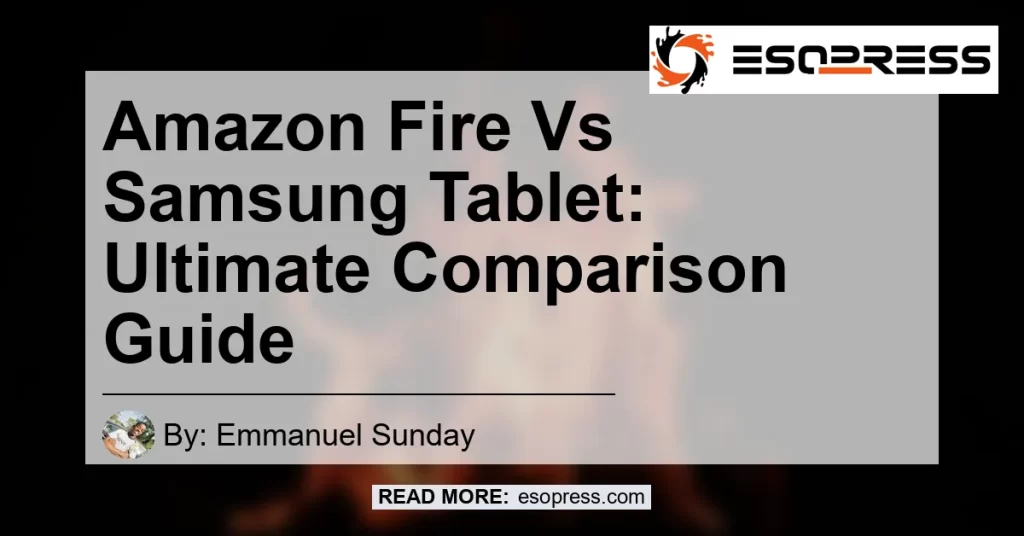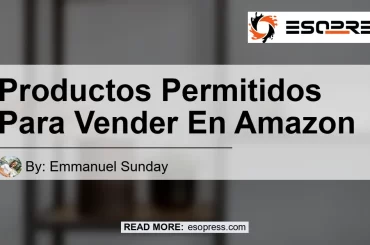

In the world of tablets, two major players stand out: Amazon Fire and Samsung. Both brands offer a wide range of tablets with various features and capabilities. But what sets them apart? In this comprehensive comparison guide, we will delve into the key differences between Amazon Fire and Samsung tablets to help you make an informed decision. So without further ado, let’s dive into the world of Amazon Fire vs Samsung Tablet!
Contents
- 1 Table of Contents
- 2 1. Introduction to Amazon Fire and Samsung Tablet
- 3 2. Operating System: Android vs Fire OS
- 4 3. Tablet Models: Samsung Galaxy Tab S8 vs Amazon Fire Tablet
- 5 4. Screen Quality: Samsung Takes the Lead
- 6 5. Processing Power: Samsung for the Win
- 7 6. Storage Options: Samsung Comes Out on Top
- 8 7. Camera Capabilities: Samsung Shines Bright
- 9 8. Application Access: Samsung Tablets Take the Lead
- 10 9. Price Range: Amazon Fire Offers Affordability
- 11 10. Pros and Cons of Amazon Fire Tablets
- 12 11. Pros and Cons of Samsung Tablets
- 13 12. Conclusion: Our Top Recommended Product in the Amazon Fire vs Samsung Tablet Battle
Table of Contents
- Introduction to Amazon Fire and Samsung Tablet
- Operating System: Android vs Fire OS
- Tablet Models: Samsung Galaxy Tab S8 vs Amazon Fire Tablet
- Screen Quality: Samsung Takes the Lead
- Processing Power: Samsung for the Win
- Storage Options: Samsung Comes Out on Top
- Camera Capabilities: Samsung Shines Bright
- Application Access: Samsung Tablets Take the Lead
- Price Range: Amazon Fire Offers Affordability
- Pros and Cons of Amazon Fire Tablets
- Pros and Cons of Samsung Tablets
- Conclusion: Our Top Recommended Product in the Amazon Fire vs Samsung Tablet Battle
1. Introduction to Amazon Fire and Samsung Tablet
Amazon Fire and Samsung tablets are two of the most popular tablet brands in the market. While they both offer a range of models, there are significant differences between them. The main distinction lies in the operating system used by each brand. Samsung tablets run on Google Android, while Fire tablets operate on the Fire OS, a customized version of Android developed by Amazon.
2. Operating System: Android vs Fire OS
The operating system is where the main difference between Amazon Fire and Samsung tablets becomes evident. Samsung tablets run on Google Android, which is known for its versatility, vast app store, and seamless integration with other Google services. On the other hand, Amazon Fire tablets use the Fire OS, a customized version of Android developed by Amazon. While the Fire OS offers a unique user interface and access to the Amazon Appstore, it doesn’t provide access to Google services like the Google Play Store or Google Maps.
3. Tablet Models: Samsung Galaxy Tab S8 vs Amazon Fire Tablet
Samsung tablets encompass a broad range of tablet models, but the most popular among them are the Samsung Galaxy Tab S8 and its Plus version. These tablets boast high-resolution screens, powerful processors, ample storage options, and impressive camera capabilities.
On the other hand, Amazon Fire tablets are available in various models, such as Fire HD 10, Fire HD 8, and Fire 7. While they may not compete with Samsung tablets in terms of specifications, they offer a budget-friendly option for those looking for a basic tablet experience.
4. Screen Quality: Samsung Takes the Lead
When it comes to screen quality, Samsung tablets outshine their Amazon Fire counterparts. Samsung tablets boast vibrant and high-resolution displays with excellent color reproduction and sharpness. The Galaxy Tab S8, for instance, features a Super AMOLED display that offers deep blacks, vivid colors, and wide viewing angles.
On the other hand, Amazon Fire tablets, while decent, don’t offer the same level of screen quality as Samsung tablets. They still provide a satisfactory viewing experience, but the colors may not be as vibrant, and the sharpness may not be on par with the Samsung tablets.
5. Processing Power: Samsung for the Win
In terms of processing power, Samsung tablets take the lead. They are equipped with powerful processors that can handle resource-intensive tasks such as gaming and multitasking. The Samsung Galaxy Tab S8, for example, is powered by a Snapdragon 888 processor, ensuring smooth performance and responsiveness.
While Amazon Fire tablets may not offer the same level of processing power as Samsung tablets, they still provide decent performance for everyday tasks like web browsing, video streaming, and reading e-books.
6. Storage Options: Samsung Comes Out on Top
When it comes to storage options, Samsung tablets offer more variety and flexibility compared to Amazon Fire tablets. Samsung tablets typically come with built-in storage options ranging from 64GB to 1TB, allowing users to store a vast amount of content, including apps, photos, videos, and documents.
On the other hand, Amazon Fire tablets offer more limited storage options, usually starting from 16GB up to 64GB. However, Amazon provides additional cloud storage options for Fire tablet users, allowing them to free up space on their devices.
7. Camera Capabilities: Samsung Shines Bright
For those who prioritize camera capabilities in a tablet, Samsung tablets are the clear winners. Samsung tablets, especially the Galaxy Tab S8, feature high-quality rear and front-facing cameras, enabling users to capture stunning photos and videos. The cameras on Samsung tablets come equipped with features like autofocus, image stabilization, and a variety of shooting modes.
In comparison, Amazon Fire tablets have more basic camera capabilities. While they can capture decent photos and videos, they may not offer the same level of image quality and advanced camera features found in Samsung tablets.
8. Application Access: Samsung Tablets Take the Lead
When it comes to accessing applications, Samsung tablets offer a clear advantage. Since they run on Google Android, users have access to the extensive Google Play Store, which hosts millions of apps and games. This allows Samsung tablet users to download and enjoy a wide range of applications, including popular ones like Netflix, Spotify, and Instagram.
On the other hand, Amazon Fire tablets use the Amazon Appstore, which has a more limited selection of apps compared to the Google Play Store. While the Amazon Appstore does host popular apps like Facebook and Twitter, some apps may be missing or have limited functionality.
9. Price Range: Amazon Fire Offers Affordability
One of the standout features of Amazon Fire tablets is their affordability. Amazon offers a range of Fire tablet models at budget-friendly prices, making them accessible to a wide range of users. Prices for Amazon Fire tablets start as low as $70, making them an excellent option for those on a tight budget or looking for a basic tablet experience.
On the other hand, Samsung tablets are positioned in the higher price range. The Samsung Galaxy Tab S8 and its Plus version can cost between $500 to $700, depending on the specifications and storage options. While they offer premium features and enhanced performance, they may not be as accessible to budget-conscious consumers.
10. Pros and Cons of Amazon Fire Tablets
Let’s delve into the pros and cons of Amazon Fire tablets to get a better understanding of their strengths and weaknesses:
Pros:
– Affordability: Amazon Fire tablets offer a budget-friendly option for those looking for a basic tablet experience.
– Access to Amazon Services: Fire tablets provide seamless access to Amazon services, including Prime Video, Kindle E-books, and Amazon Music.
Cons:
– Limited App Selection: The Amazon Appstore has a more limited selection of apps compared to the Google Play Store, which may result in missing or limited functionality for certain applications.
– Less Powerful Specifications: Amazon Fire tablets may not offer the same level of screen quality, processing power, and camera capabilities as other high-end tablets.
11. Pros and Cons of Samsung Tablets
Now let’s explore the pros and cons of Samsung tablets to understand their advantages and disadvantages:
Pros:
– High-Quality Display: Samsung tablets boast vibrant and high-resolution displays that offer an immersive viewing experience.
– Powerful Performance: Samsung tablets come equipped with powerful processors, providing smooth multitasking and gaming capabilities.
– Extensive App Selection: Samsung tablets run on Google Android, allowing access to the vast Google Play Store with millions of apps and games.
Cons:
– Higher Price Range: Samsung tablets tend to be more expensive compared to other tablet brands, making them less accessible to budget-conscious consumers.
– Limited Integration with Amazon Services: Unlike Amazon Fire tablets, Samsung tablets don’t offer seamless integration with Amazon services, which may be a disadvantage for Amazon Prime members.
12. Conclusion: Our Top Recommended Product in the Amazon Fire vs Samsung Tablet Battle
After a thorough comparison of Amazon Fire and Samsung tablets, the Samsung Galaxy Tab S8 emerges as our top recommended product in the Amazon Fire vs Samsung Tablet battle. With its high-quality display, powerful performance, extensive app selection, and impressive camera capabilities, the Samsung Galaxy Tab S8 offers a premium tablet experience.
To explore and purchase the Samsung Galaxy Tab S8, visit this Amazon search link.


In conclusion, when choosing between Amazon Fire and Samsung tablets, it ultimately comes down to your specific needs, preferences, and budget. Both brands offer unique features and capabilities that cater to different user requirements. Whether you prioritize affordability, screen quality, processing power, or camera capabilities, there is a tablet out there for you. We hope this ultimate comparison guide has provided you with valuable insights to help you make an informed decision in the Amazon Fire vs Samsung Tablet battle. Happy tablet shopping!






